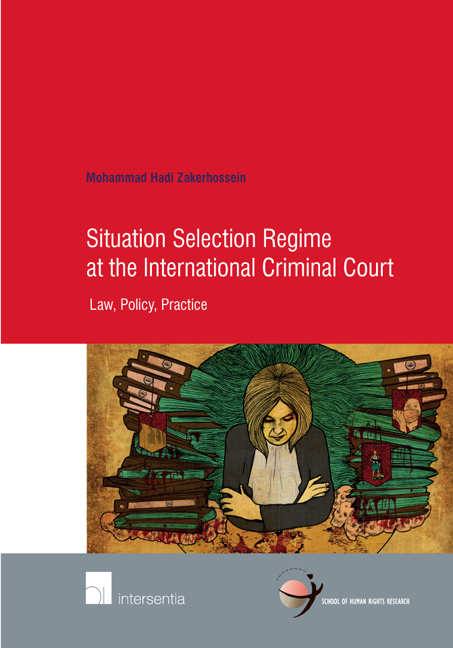Book contents
- Frontmatter
- Contents
- Acknowledgment
- Abbreviations
- General Introduction
- Part One Formulating the Concept of Situation in the Rome Statute Sense
- Part two Situation Selection Process
- Part three Situation Selection Criteria
- Part Four Situation Selection In Light Of Expressivism
- Chapter I Conceptualization of Expressivism in the Context of the ICC
- Chapter II Implications of Expressivism on the Situation Selection
- Conclusion
- Bibliography
- ICC Case Tables
- OTP Documents
- About the Author
- School of Human Rights Research Series
Chapter II - Implications of Expressivism on the Situation Selection
from Part Four - Situation Selection In Light Of Expressivism
Published online by Cambridge University Press: 13 October 2018
- Frontmatter
- Contents
- Acknowledgment
- Abbreviations
- General Introduction
- Part One Formulating the Concept of Situation in the Rome Statute Sense
- Part two Situation Selection Process
- Part three Situation Selection Criteria
- Part Four Situation Selection In Light Of Expressivism
- Chapter I Conceptualization of Expressivism in the Context of the ICC
- Chapter II Implications of Expressivism on the Situation Selection
- Conclusion
- Bibliography
- ICC Case Tables
- OTP Documents
- About the Author
- School of Human Rights Research Series
Summary
As discussed, the expressive functions of the Court has two main audiences, States and victims. Adopting expressivism as the normative framework within which the situation selection at the ICC should be framed and shaped has some implications in relation to both victims and States.
SELECTION OF A SITUATION FOR CONDUCTING PRELIMINARY EXAMINATION AS A PLATFORM TO SERVE VICTIMS
As mentioned, the ICC is unable to address needs of all victims, and to hear voices of all affected people, and to cover all kinds of victimhood. The Court has to select relatively few situations for investigation and an even smaller number of cases for prosecution. Such selectivity is, however, justified by expressivism. The Court takes action in an exemplary and expressive way. This criminal institution is intended to create, project and promote some norms at the international level, and to keep the victims’ hope to see justice alive. Therefore, the Court is not intended to operate in a far-reaching and inclusive manner. Nonetheless, the Court has adopted some mechanisms to enhance the scope of its expressive initiatives in order to reach a larger number of victims. In this regard, the most meaningful mechanism that serves the expressive mandates of the Court is preliminary examination. Preliminary examination is unique for the Court. This procedural stage has been designed to serve the specific goals of the Court, given its selectivity. International crimes are committed in the context of mass atrocities, mass victimization, and mass perpetrators. However, the preliminary examination phase is capable to broaden the scope of the Court's intervention.
The Court's action is limited neither to few cases, nor to investigation and prosecution. This is a major difference between the Court and other criminal tribunals at the domestic level that should be taken into account in the understanding of the Court. The procedure and architecture of the Court have been constructed based on the special features and needs of the Court. In the preliminary examination, the Prosecutor of the Court enjoys flexibility. Many legal and practical restrictions in the investigation and prosecution phases are absent from the preliminary examination. The Prosecutor can easily start a preliminary examination. Only those situations that are manifestly outside of the jurisdiction of the Court remain behind the closed doors of the Court.
- Type
- Chapter
- Information
- Situation Selection Regime at the International Criminal CourtLaw, Policy, Practice, pp. 389 - 400Publisher: IntersentiaPrint publication year: 2017

